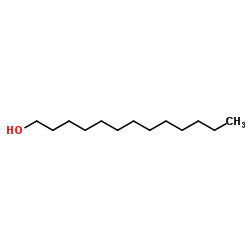1-Tridecanol

1-Tridecanol structure
|
Common Name | 1-Tridecanol | ||
|---|---|---|---|---|
| CAS Number | 112-70-9 | Molecular Weight | 200.361 | |
| Density | 0.8±0.1 g/cm3 | Boiling Point | 272.1±3.0 °C at 760 mmHg | |
| Molecular Formula | C13H28O | Melting Point | 29-34 °C(lit.) | |
| MSDS | Chinese USA | Flash Point | 121.1±4.6 °C | |
| Symbol |

GHS07 |
Signal Word | Warning | |
|
Actions of general anaesthetics on a neuronal nicotinic acetylcholine receptor in isolated identified neurones of Lymnaea stagnalis.
Br. J. Pharmacol. 115(2) , 275-82, (1995) 1. Completely isolated identified neurones from the right parietal ganglion of the pond snail Lymnaea stagnalis were studied under two-electrode voltage-clamp. Neuronal nicotinic acetylcholine receptor currents were studied at low acetylcholine (ACh) concentr... |
|
|
Surface potential changes in lipid monolayers and the 'cut-off' in anaesthetic effects of N-alkanols.
Biochim. Biophys. Acta 863(2) , 337-40, (1986) The effects of 0.09 saturated solutions of the n-alkanols n-hexanol to n-tridecanol on the surface (compensation) potential of lipid monolayers have been examined. Actions on monolayers spread from pure egg phosphatidylcholine have been compared with effects ... |
|
|
Antibacterial activity and chemical composition of essential oil of Pamburus missionis.
J. Ethnopharmacol. 124(1) , 151-3, (2009) The aerial parts of Pamburus missionis (Wight) Swingle (Rutaceae) are traditionally used in the treatment of swelling, chronic rheumatism, paralysis, and puerperal diseases.The aim of this work was to investigate the chemical composition and antibacterial act... |
|
|
A statistical mechanical analysis of the effect of long-chain alcohols and high pressure upon the phase transition temperature of lipid bilayer membranes.
Biochim. Biophys. Acta 1066(2) , 225-8, (1991) Long-chain n-alcohols decrease the main phase-transition temperature of lipid vesicle membranes at low concentrations but increase it at high concentrations. The nonlinear phenomenon is unrelated to the interdigitation and is analyzed by assuming that alcohol... |